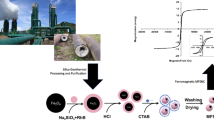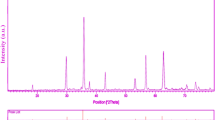Abstract
Inspired by the naturally occurring fluorescent mineral, ferroan sphalerite, [(Fe,Zn)S] nanoparticles were synthesized by a three component reaction of [Fe(Mes)2]2 (Mes = mesityl or C6H2Me3-2,4,6), [Zn(Et)(ONep)(py)]2, and elemental S via both solution and solvothermal routes. The resultant nanoparticles are ≤3 nm and absorb at λmax = 281 nm emitting a bright blue color (λem ∼400 nm).




Similar content being viewed by others
References
Murray CB, Norris DJ, Bawendi MG (1993) J Am Chem Soc 115:8706
Derfus AM, Chan WCW, Bhatia SN (2004) Nano Lett 4:11
http://images.google.com/sphalerite
http://mineral.galleries.com/minerals/fablocal/franklin.htm
http://www.sterlinghill.org/
Gao W, Yin H, Cui QL, Li MH, Yang HB, Cui T, Zou GT (2004) Appl Phys A 78:749
Ma X, Xu F, Wang X, Du Y, Chen L, Zhang Z (2005) J Cryst Growth 277:314
Bredol M, Althues H. Proceed. Symp. F, Eur Mater Res Soc Fall Meet 2003, Warsaw, Poland, 2004; Warsaw, Poland, 2004; p 19
Horii Y, Kitagawa M, Taneoka H, Kusano H, Murakami T, Hino Y, Kobayashi H. 2nd Asia Pac. Symp. Org. Electrolum. Mater. Dev., Hong Kong, China, 2001; Hong Kong, China, 2001; p 92
Karar N, Chander H, Shivaprasad SM (2004) Appl Phys Lett 84:1189
Lu SW, Lee BI, Wang ZL, Tong W, Wagner BK, Park W, Summers CJ (2001) J Lumin 92:73
Kashyout AB, Arico AS, Giordano N, Antonucci V (1995) Mater Chem Phys 41:55
Deulkara SH, Bhosalea CH, Sharon M (2004) J Phys Chem Solids 65:1879
Babic Stojic B, Soskic Z, Stojic M, Milivojevic D (1999) J Magnetism Magnet Mater 195:76
Twardowski A, Swagten HJM, de Jonge WJM (1991) Phys Rev B 44:2220
Behboudnia M, Sen P (2001) Phys Rev B 63:035316
Boyle TJ, Rodriguez MA, Ingersoll D, Headley TJ, Bunge SD, Pedrotty DM, De’Angeli SM, Vick SC, Fan HY (2003) Chem Mater 15:3903
Bunge SD, Krueger KM, Boyle TJ, Rodriguez MA, Headley TJ, Colvin VL (2003) J Mater Chem 13:1705
Boyle TJ, Bunge SD, Andrews NL, Matzen LE, Sieg K, Rodriguez MA, Headley TJ (2004) Chem Mater 16:3279
Bunge SD, Boyle TJ, Headley TJ (2003) Nano Lett 3:901
General Synthesis of (FeZn)S Nanoparticles. Two routes were explored to synthesize the ferroan sphalerite nanoparticles. All compounds described below were handled with rigorous exclusion of air and water using standard Schlenk line and glove box techniques. Octadecene and toluene were stored under argon and used as received (Aldrich) in SureSeal™ bottles. (A) The first route used a mixture of [Fe(Mes)2]2 (0.022 g, 0.037 mmol) and [Zn(Et)(ONep)(py)]2 (0.25 g, 0.69 mmol) dissolved in 25 mL of toluene. This solution is placed in three-neck round bottom equipped with a reflux condenser and a septum. Under flowing argon, the solution is brought to reflux conditions (∼200 °C) and 1 mL of a solution of S (0.023 g, 0.73 mmol) dissolved in octadecene was injected via syringe. A turbid dark brown solution formed immediately and the mixture stirred for 30 min at reflux conditions then was cooled to room temperature. After centrifugation, a yellow mother liquor and brown precipitate was collected. (B) The second route used a 48 mL Parr acid digestion bomb. In the glove box, 15 mL of toluene was added to [Fe(Mes)2]2, [Zn(Et)(ONep)(py)]2, and elemental sulfur in the Teflon vessel. The reaction was heated at 10 °C/min to 200 °C and held at this temperature for 48 h. After cooling, a turbid dark brown solution was collected and centrifuged. Again, a yellow mother liquor and brown precipitate was isolated. An aliquot of the particles dispersed in the mother liquor was placed directly onto a Carbon Type-B copper Transmission Electron Microscopy (TEM). TEM grid (300 mesh) purchased from Ted Pella, Inc. The aliquot was then allowed to dry overnight. The resultant particles were studied using a Philips CM 30 TEM operating at 300 kV accelerating voltage
Skoog DA, Holler FJ, Nieman TA (1998) Principles of instrumental analysis, 5th edn. Saunders College Publishing: Philadelphia
Torres-Martinez CL, Nguyen L, Kho R, Bae W, Bozhilov K, Klimov V, Mehra RK (1999) Nanotechnology 10:340
Wageh S, Shu-Man L, You TF, Xu-Rong X (2003) J Lumin 102(103):768
Dubertret B, Skourides P, Norris DJ, Noireaux V, Brivanlou AH, Libchaber A (2002) Science 298:1759
Fan HY, Leve EW, Scullin C, Gabaldon J, Tallant D, Bunge S, Boyle TJ, Wilson MC, Brinker CJ (2005) Nano Lett 5:645
Hanshaw RG, Lakshmi C, Lambert TN, Johnson JR, Smith BD (2005) ChemBioChem 6:2214
Acknowledgement
Drs J. Oliver and B. Wilson (University of New Mexico) for helpful discussions. Support for this work was by: the National Institutes of Health through the NIH Roadmap for Medical Research, Grant 1 R21 EB005365-01 where information on this RFA (Innovation in Molecular Imaging Probes) can be found at http://grants.nih.gov/grants/guide/rfa-files/RFA-RM-04-021.html; the Office of Basic Energy Sciences at the Department of Energy, and the United State Department of Energy. Sandia is a multiprogram laboratory operated by Sandia Corporation, a Lockheed Martin Company, for the United States Department of Energy under contract DE-AC04-94AL85000.
Author information
Authors and Affiliations
Corresponding author
Additional information
The synthesis of fluorescent ferroan sphalerite nanoparticles that emit at ∼400 nm was realized through solution and solvothermal routes.
Rights and permissions
About this article
Cite this article
Boyle, T., Pratt, H., Hernandez-Sanchez, B. et al. Synthesis and optical properties of naturally occurring fluorescent mineral, ferroan sphalerite, inspired (Fe,Zn)S nanoparticles. J Mater Sci 42, 2792–2795 (2007). https://doi.org/10.1007/s10853-006-1419-3
Received:
Accepted:
Published:
Issue Date:
DOI: https://doi.org/10.1007/s10853-006-1419-3




